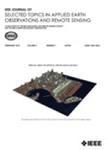版权所有:内蒙古大学图书馆 技术提供:维普资讯• 智图
内蒙古自治区呼和浩特市赛罕区大学西街235号 邮编: 010021

作者机构:Shanghai Ocean Univ Coll Informat Technol Shanghai 201308 Peoples R China Shanghai Jian Qiao Univ Coll Informat Technol Shanghai 201315 Peoples R China
出 版 物:《IEEE JOURNAL OF SELECTED TOPICS IN APPLIED EARTH OBSERVATIONS AND REMOTE SENSING》 (IEEE J. Sel. Top. Appl. Earth Obs. Remote Sens.)
年 卷 期:2025年第18卷
页 面:569-583页
核心收录:
学科分类:0808[工学-电气工程] 1002[医学-临床医学] 08[工学] 0705[理学-地理学] 0816[工学-测绘科学与技术]
基 金:National Key Research and Development Program of China [2021YFC3101601] National Natural Science Foundation of China
主 题:Superresolution Remote sensing Spatial resolution Feature extraction Fast Fourier transforms Deep learning Current transformers Image reconstruction Convolutional neural networks Frequency-domain analysis Convolutional neural network (CNN) fast Fourier transform (FFT) remote sensing image processing super resolution (SR) transformer
摘 要:The objective of super-resolution in remote sensing imagery is to enhance low-resolution images to recover high-quality details. With the rapid progress of deep learning technology, the deep learning-based super-resolution technology for remote sensing images has also made remarkable achievements. However, these methods encounter several challenges. They often struggle with processing long-range spatial information that encompasses complex scene changes, adversely affecting the image s coherence and accuracy. Furthermore, the lack of connectivity in feature extraction blocks hinders effective feature utilization in deeper network layers, leading to issues such as gradient vanishing and exploding. Additionally, constraints in the spatial domain of previous methods frequently result in severe shape distortion and blurring. To address these issues, this study proposes the CFFormer, a new super-resolution framework that employs the Swin Transformer as its core architecture and incorporates the Channel Fourier Block (CFB) to refine features in the frequency domain. The Global Attention Block (GAB) is also integrated to enhance global information capture, thereby improving the extraction of spatial features. To increase model stability and feature utilization efficiency, a Jump-Joint Fusion Mechanism is designed, culminating in a Residual Fusion Swin Transformer Block (RFSTB) that alleviates the gradient vanishing issue and optimizes feature reuse. Experimental results confirm the CFFormer s superior performance in remote sensing image reconstruction, demonstrating outstanding perceptual quality and reliability. Notably, the CFFormer achieves a Peak Signal-to-Noise Ratio (PSNR) of 29.83 dB on the UcMercedx4 dataset, surpassing the SwinIR method by approximately 0.5 dB, indicating a substantial enhancement.